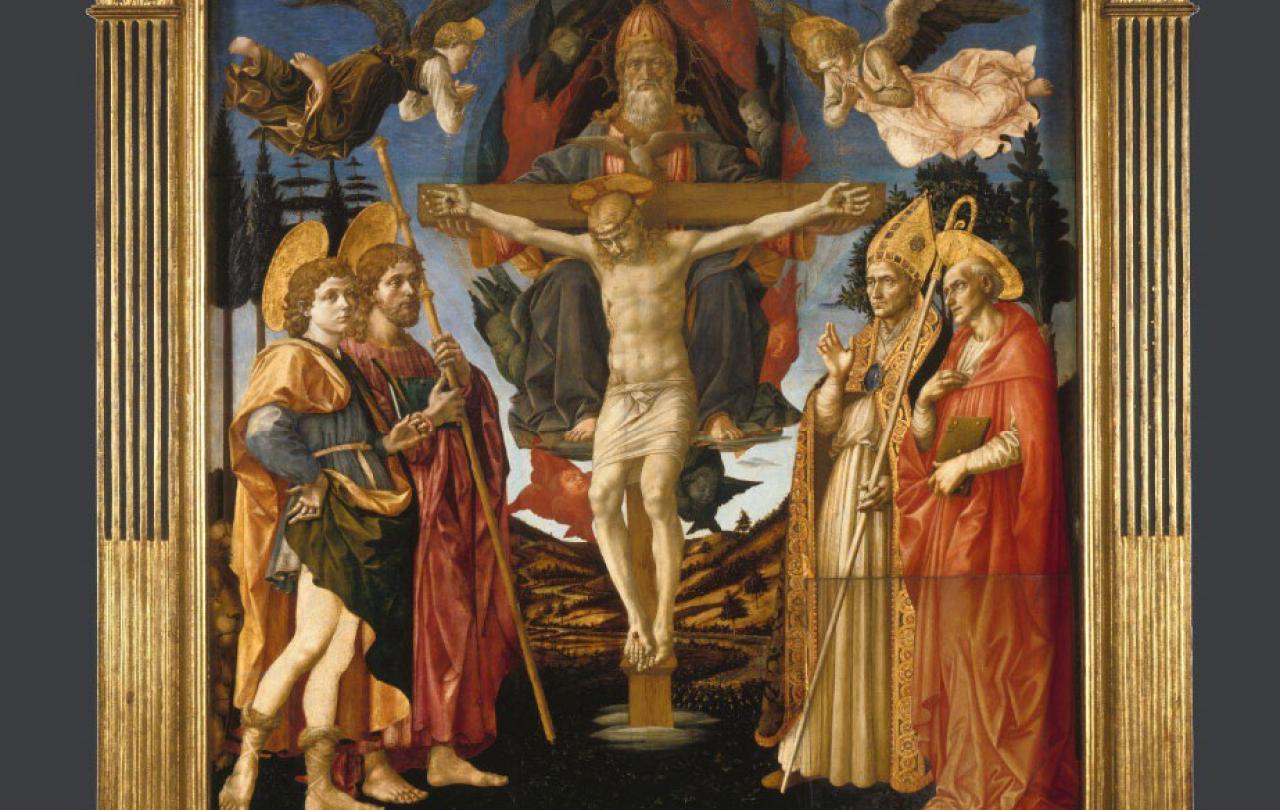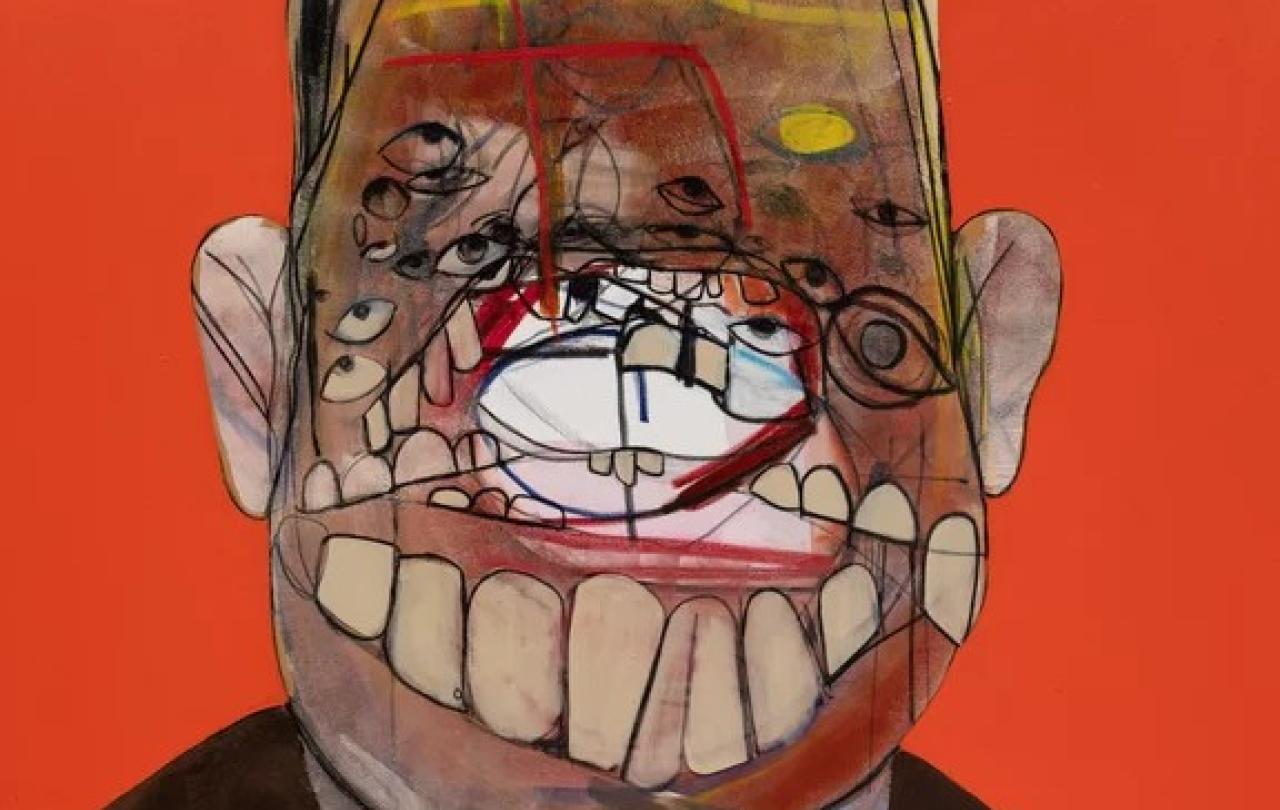
My favourite idol features prominently in National Gallery’s new exhibition of paintings by Francesco Pesellino (1422–1457). I say that by way of provocation: I don’t really think it’s an idol, but that is how it was described to me – by a ten-year-old – in one of the best conversations I’ve ever had as a teacher.
That was fifteen years ago. I was in the gallery to give a theological tour, as part of a Confirmation class for Westminster Abbey. Half an hour in, we came to Pesellino’s Pistoia Altarpiece. It’s a glorious painting, but I was unconvinced by what it sets out to do, with its dead Christ within a portrayal of the Trinity of Father, Son, and Holy Spirit. The doctrine of the Trinity is about the nature of God, as love and life, and there’s no death there.
Not that I mean to single out Pesellino for criticism. He isn’t the only painter to represent God that way. Massacio’s version is one of the most significant works of the early Florentine Renaissance, resurrecting linear perspective in painting. Just down the road from the National Gallery, at the Courtauld Institute, there’s a similar painting of the Trinity by Botticelli. They’re all magnificent, I just think that if you’re going to try to depict God, the emphasis should be on life.
Standing before Pesellino’s painting fifteen years ago, with those misgivings in mind, I asked the dozen or so kids in the Confirmation class what might be wrong with what the painter as trying to do. One child replied instantly: ‘Please Father, it is an idol.’ Dread rose within me. This child was an Arab Christian. Had he, I wondered, grown up in a culture that treated religious art as idolatrous? Had I offended his conscience continuously for the past half hour, with painting after painting? Best to find out. ‘Have the other paintings been idols?’, I asked. ‘No’, he replied. ‘Why not? Why is this one bad?’ His reply came without pause: ‘Because there’s God the Father in it.’ This was getting interesting. ‘So’, I asked, ‘it’s OK to show Jesus, like the other paintings we’ve seen today, but not God the Father?’ ‘Yes’, was his firm opinion.
These are deep waters, and this was a thoughtful child. To this day, the Orthodox Churches generally forbid depicting of God the Father in icons. Then came one of the most glorious moments of my life as a teacher. ‘Why’s that?’, I asked. ‘Why can we paint Jesus, but not the Father?’ The boy stood silent for some moments. ‘Because’, he said, the cogs of his mind clearly turning, ‘because… because God has made an image of himself in Jesus… You could see Jesus… so you can paint him.’ This was no pre-packaged answer. He was not recycling anything he’d been told before. He was recapitulating the arguments of the Seventh Ecumenical Council (at Nicaea, in AD 787) in real time.
The eight century was a turbulent time when it comes to religious images. They were supressed in the Byzantine Empire from around AD 730, with a firm condemnation in AD 754. Twenty-three years later, at Nicaea, the church reversed the ban. The decisive argument was formulated by St John of Damascus (AD 675 or 676 – 749): ‘When the Invisible One becomes visible to flesh, you may then draw a likeness of His form.’ It’s the same position as our young theologian in the National Gallery had got to on his own.
In this way, Christian art rest on Christmas: on the Incarnation, on God’s coming-into-the-flesh. Heir to the Judaic prohibition of ‘graven images’ Christianity – or most of it – made its peace with depicting holy things, and art in churches, because of Christmas, where we see ‘God made visible’ in Jesus.
In the mystery of the Word made flesh
the light of your glory has shone anew upon our minds
that seeing here God made visible,
we may be caught up in love for God whom we cannot see.
Those are words from the central acclamation of Christmas (the Eucharistic preface) at Midnight Mass (and at Holy Communion for the rest of Christmastide). ‘Seeing here God made visible’.
The events of Christmas form one of the two poles of Christian art. Some delightful examples feature in the Pesellino exhibition: a virgin and child and an Annunciation. The other supremely worthy subject for Christian art is the crucifixion and all that surrounds it. As I have noted, in the current exhibition the crucifixion features in his Trinity altarpiece. God’s humanity is most clearly witnessed at the beginning of Christ’s life, and at the end.
In the intervening years, I have mellowed towards Pesellino’s painting, and that way of depicting something about God. Painting the eternal reality of God is impossible, but in Jesus we see what we need to see. There is no death in God, but the crucifixion is what God’s life looks like when it is made flesh in a world full of evil. The crucifixion shows God’s embrace of human life to the furthest extremes of suffering and degradation. It shows the life of God overcoming death. We can hold onto what the crucifixion offers in a painting like this one, while remembering that the Resurrection underlines the priority of God’s life over death. One painting can’t say everything.
Those fifteen years ago, I was aware that I’d been in a remarkable exchange, one that I would not forget. As I found across my time as a curate, children ask the best theological questions. That might be reason to go to see the Pesellino exhibition with a child. Alongside the paintings I have mentioned already, there are also two gloriously child-friendly panels, each showing multiple events from the life of King David. They offer a sort of fifteenth century comic strip, except that the events are fused into one long scene. Pesellino was a master at painting animals. Magnifying glasses are provided to help you search them out.
Pesellino: A Renaissance Master Revealed, The National Gallery, London, until 19 March.





